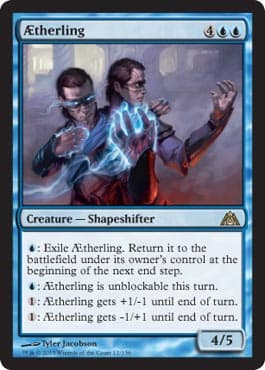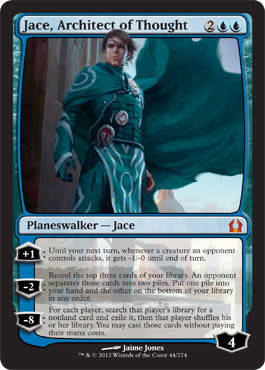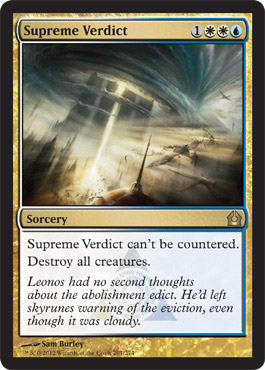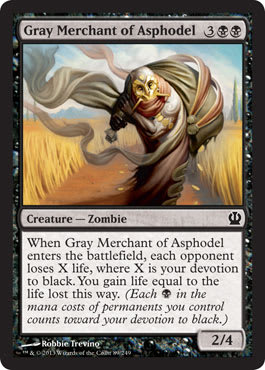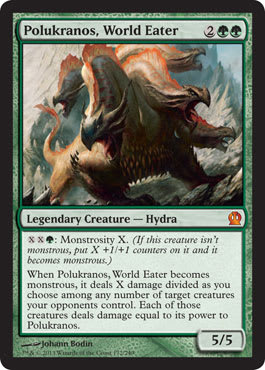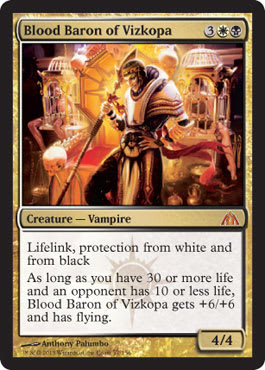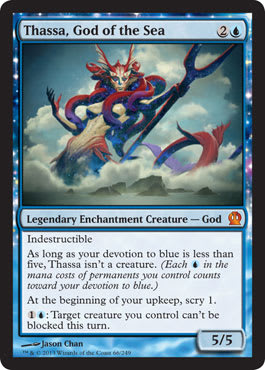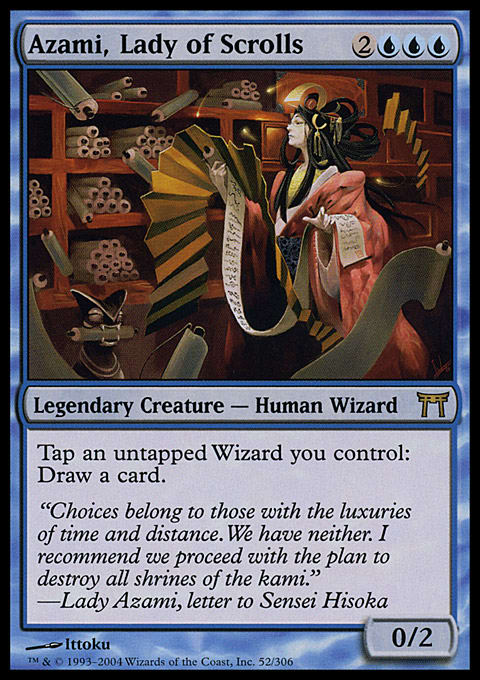We learned a lot from Cincinnati this weekend, not least of all the proclamation Brad Nelson kept making as he wound his way to the finals to face, you guessed it, an Esper mirror.
Grand Prix Cincinnati was North America’s first taste of Standard on the Grand Prix level since the release of Born of the Gods, and lost in all of the Esper-mirror-match hoopla was that we learned a ton about the texture of the format, card choices, variations on archetypes, and fallibility of Alexander Hayne.
Since I was once again off to the side hacking away at my laptop covering the 1,734-person event from start to finish, I gained a ton of insight into not only the very purposeful, very deliberate angles players were taking on the format, but also the ones that were accidental, the things that ended up mattering far more than they were intended.
Here are the highlights of what we learned in Cincinnati. Let’s start with Nelson’s proclamation.
“Esper Is the Best Deck in the Format.”
Throughout the Top 8, Brad Nelson talked repeatedly about how good the deck was and about how poorly he’s played all weekend. It was probably a bit of hyperbole to say he’s played poorly (or bradly, as he likes to say) since he still did better than every Esper player except one, but the deck is currently very powerful and very forgiving.
Everyone watching the stream probably knows just how fortunate Nelson was to win the second game against Jared Boettcher in the semifinals, thanks to some positively insane Jace flips, but Nelson’s poor play nearly cost him the first game, too, but his deck wouldn’t let him.
The scenario was that Nelson was insanely far ahead, with Jace, Architect of Thought and Elspeth, Sun's Champion against two Mutavaults, Blood Baron of Vizkopa, and some Pack Rats with a stacked hand. But he had no Supreme Verdict. Instead, he minused Elspeth to kill the Baron and used Detention Sphere to take out the Rats. Seems fine, right?
Except that, after doing all of those things, he then activated Jace and, naturally, flipped up a Supreme Verdict that would have done the job of both Elsepth and Detention Sphere.
Big deal, right? The board is clear, and he has two Planeswalkers, and, as we saw, he won.
Except it wasn’t that simple. The lapse kept him from making more Soldier tokens and left him with both ’Walkers low on loyalty. Boettcher promptly killed both Planeswalkers over the next two turns with Mutavaults (and help from a Bile Blight) and made the game much, much closer than it should have been. If Boettcher had seen an Underworld Connections at some point in there, it’s likely he would have turned that game around. Instead, he drew more lands and more blank removal spells and never put up a fight.
That’s just a micro point to illustrate a larger one. Supreme Verdict, Elspeth, Detention Sphere, and Sphinx's Revelation are very forgiving cards, giving you room to make mistakes and still just power through your opponents. That’s why Esper only lost to other Esper decks in the Top 8. That’s why so many top players came with the deck. That’s why Thoughtseize is so powerful and why players started packing Rakdos's Return, Slaughter Games, and Sire of Insanity again—because the best way to beat that many powerful cards is to just not let opponents actually play with any of them if possible.
But when Esper can cast the cards in its hand? It is heads and tails the best deck in the format.
And the numbers bore that out. It was the most common deck on Day 2 (and pretty darn common on Day 1), and five variations on the Revelation/Temples theme made Top 16.
That said, if you peruse the Top 16 decklists, you’ll notice a pattern . . .
Black Is the Best Color in Standard
Fully three of the decks in the Top 16 didn’t play at least some black cards, and seven of the Top 16 were actually black-based. In fact, there were just about as many copies of Gray Merchant of Asphodel in the Top 16 as there were Sphinx's Revelations.
It wasn’t that long ago that Mono-Black Devotion was considered the best deck in the format, mostly on the back of Owen Turtenwald’s repeated success with Pack Rat and Gary. People started leaving the deck behind as others adapted—more Blood Barons, more ways to remove Underworld Connections—even though it never really stopped being a strong choice.
Well, several things happened. First, people stopped aiming for it quite as hard as before. There were plenty of Blood Barons in the room, but some were relegated to the sideboard, and many Esper Control decks weren’t playing them at all.
Second, the deck itself adapted. Many, if not most, players started splashing either white—the most popular—or red—arguably more successful on a per-player basis. Lifebane Zombie has become a more common (and successful) main-decked addition, and Thoughtseize is still just about the best card around in a format defined by control and midrange strategies.
But it wasn’t just the devotion decks that fueled this trend. Control decks obviously chose to dip into black to combat the rise of Stormbreath Dragon while Monsters also dipped into black—oddly enough—to combat Stormbreath Dragon as well—plus a few key cards against control. Speaking of which . . .
Jund Monsters Is for Real—but Everyone Was Aiming for It
Every time I interviewed someone about why he or she was playing or thought others should play a certain type of deck (basically, my Variations on Standard series from Saturday), that person went out of his or her way to point out why one version was superior to the others. And the answer was always, “It’s better against Monsters.”
In fact, Brian Kibler was playing Jund Monsters in part because it beat up on R/G Monsters. You can always count on Kibler to play green cards, but your best bet is to pay very close attention to the colors he plays alongside them. In this case: black and red.
We didn’t really see many copies vying to be in contention, but that doesn’t mean it won’t be back when people are less vigilant.
Don’t Just Blind-Copy Winning Decklists
Kyle Boggemes’s sideboard split of two Blood Baron of Vizkopa and two Archangel of Thune looks like the kind of tweaking and metagaming that can give a player an edge. During the finals, Nelson even pointed out that Boggemes’s sideboard gave him an advantage.
It’s just that it was kind of accidental.
Boggemes, as he explained after the finals, isn’t able to play much these days. Mostly, he’s able to jump in a random Modern or Legacy event now and then only because he works about a block from a card store. Otherwise, he just isn’t able to sling spells nearly as much as he used to.
Recently, a friend offered to give him his collection, and in this collection were two Archangel of Thune, which, prior to obtaining this collection, Boggemes didn’t own. Since he now owned two Archangels, he put them in his sideboard—because he owned them.
Obviously, the split worked out and may even have some logic behind it—each creature is stronger in certain matchups, but generally speaking, the cards occupy a similar space—but you should still put a little thought into it before you just sleeve up the seventy-five that won the latest Grand Prix.
Esper Is the Best Main Deck—but What Constitutes Its Best Sideboard?
The best way to gain an edge in the mirror is probably to play some kind of disruptive creature base. Sin Collector appears to be absolutely nuts against Esper—still—and I saw it constantly giving an advantage to the player who had one. It rips a card out of the opponent’s hand, harasses Jaces, and can’t be Negated. Any Orzhovian sideboard should probably start with three of these as long as Esper remains the top dog.
Duress and Thoughtseize are also excellent in a number of matchups, though there’s obviously some overlap with Sin Collector. Revoke Existence in some number seems necessary, and Negate is pretty good, too. Gainsay is fine, but there probably isn’t enough of Mono-Blue to justify it. Dispel is really good as well.
But then there are the creature plans. Notion Thief, Blood Baron, Obzedat, Ghost Council, Nightveil Specter, and Archangel of Thune all make pretty good cases. Fiendslayer Paladin and Soldier of the Pantheon have their applications.
Mono-Blue Devotion Is a Very Different Deck Than U/w Devotion. Very different.
I watched Jeffrey Pyka march all the way to the Top 8 with a version of Blue Devotion he said chose “power over consistency” by way of the white splash, and I have to agree. I’ve played a bit of Mono-Blue since Pro Tour Theros, and that deck is very much a tempo deck that looks to win before your opponents can really their feet under themselves. The white splash, however, shifts the deck from a pure tempo deck to one that takes its time and leans more and more on both Thassa, God of the Sea and Master of Waves to win the game.
The way Pyka typically played it was to put one or two threats on the board and back them up with either Thassa, Ephara, God of the Polis, or Bident of Thassa and patiently wait to reload. The fact that Detention Sphere sits in play most of the time meant he could usually turn on Thassa at will simply by sandbagging whatever random creatures he had. They would often die, but not before Thassa was able to Lava Axe the opponent.
And having two Gods in the deck seriously ratchets up the ability to go up to 11 (the combined power of Thassa and Ephara—and, yes, also a Spinal Tap reference), which I saw Pyka do several times simply by having Detention Sphere in play.
Talking to Sam Black about the deck revealed that he still very much wanted to be on the tempo plan, but as the format develops, and as black decks continue to dominate, we might want to look toward power over consistency.
You Can Play Several Variations of All of the Top Decks
There are a bunch of versions of black-based midrange decks, W/U/x Control, Monsters, and Blue Devotion that start with the same core and then branch out based on what splash color you feel like playing. Generally speaking, this phenomenon is due to the Temples being nearly free-rolls in a lot of decks because the format is pretty slow.
And yes, those links are some shameless shilling for more of my own writing. But they also cover a ton of information, more than I have room for in this particular article. If you’re looking for a deeper look at the variations within Standard’s top archetypes, I’d start there.
Things I Think I’m Thinking
- Remember that Cruel Control deck I’m always talking about? Sixteenth-ranked Josh McClain, Modern master and former Friday Night Magic sparring buddy took it for a spin in a Modern box tournament the Friday before Grand Prix Cincinnati. He obviously won. He excitedly told me he Crueled someone four times in one match. I still think the deck is very real. I probably won’t be able to make it to Grand Prix Minneapolis . . . but I really want to.
- Corbin Hosler was my written coverage copilot this weekend and was awesome. Expect to see more of him at events in the future.
- I realized the other day that the last time I played in a Pro Tour Qualifier was probably during the Bush administration.
- I’m very, very slowly foiling out my Azami, Lady of Scrolls Commander deck, recently picking up copies of Sower of Temptation, Duplicant, Phyrexian Metamorph, and Sculpting Steel. Really dreading having to pick up Vendilion Clique, but at the price Volcanic Island is going for, I can probably just trade it in for two. Foil Fabricate is oddly hard to find.
- I suck at unpowered Cube. It took the combined might of Jace, the Mind Sculptor, Upheaval, Jace Beleren, Ral Zarek, Gilded Lotus, Domri Rade, and Opposition to finally win a Draft. I miss Holiday Cube.
















